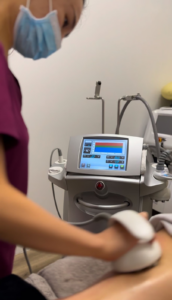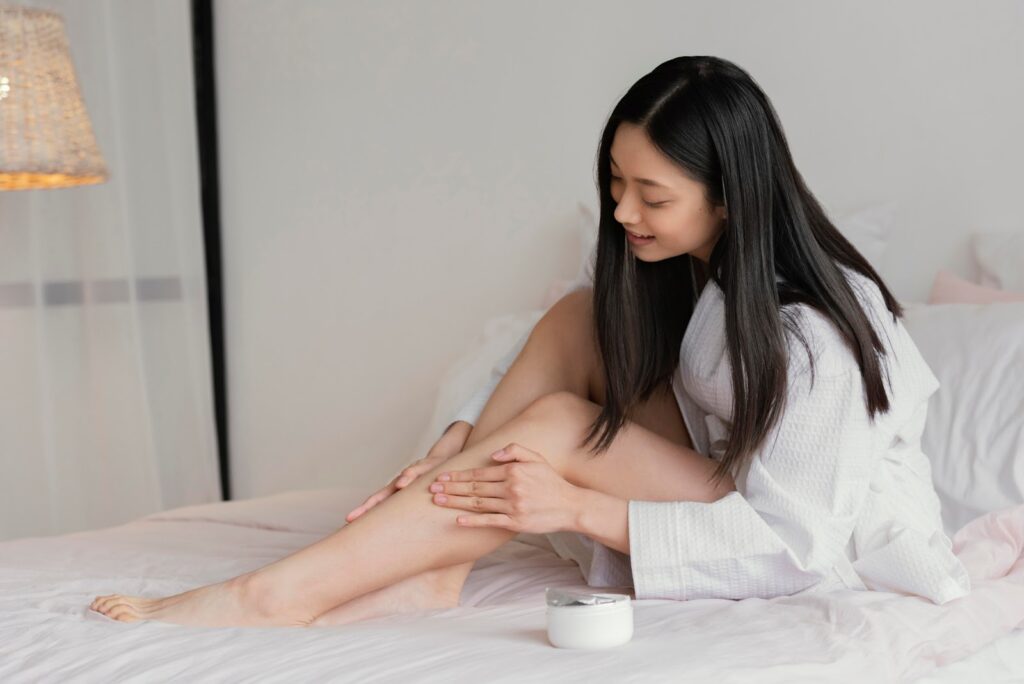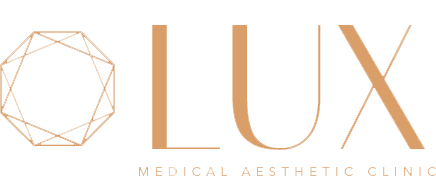Cellulite is a common cosmetic skin concern that affects many people. Although it’s not a medical condition, some individuals may feel self-conscious about their skin. Fortunately, there are treatment options that may help reduce the appearance of cellulite.
What is Cellulite?

Cellulite is a harmless skin condition characterised by a lumpy or dimpled texture, often compared to an “orange peel” or “cottage cheese” appearance. It occurs when fat deposits push through the connective tissue beneath the skin, causing an uneven skin surface. Cellulite is more common in women than men due to differences in fat distribution, muscle structure, and connective tissue.
What causes cellulite?
A study estimates that cellulite occurs in 80% to 90% of females and is commonly observed on the thighs, hips, buttocks, and abdomen. Cellulite forms due to the uneven tightening of the fibrous bands (septae) that link the skin to the underlying muscle (fascia). This tightening pulls the skin downwards while fat deposits beneath the skin push upwards, resulting in a lumpy appearance on the skin’s surface.
Cellulite can develop in individuals with varying body types and weights. Various factors can lead to the formation of cellulite in the body, including:
1. Genetics
Your genetic makeup significantly influences your likelihood of developing cellulite. Genetic predisposition can influence skin structure, fat distribution, and even blood circulation, all affecting cellulite’s appearance. People with family members who have cellulite are more likely to experience it themselves.
According to a study, certain genes, like HIF1A and ACE, are linked to cellulite development, as they affect fat storage and the elasticity of connective tissues.
- H1F1A (Hypoxia-Inducible Factor 1-Alpha)
HIF1A is a gene that regulates the body’s response to low oxygen (hypoxia) in tissues. It plays a crucial role in adipogenesis (fat cell formation) and blood vessel remodelling, which impacts cellulite development.
When tissues experience hypoxia, particularly in regions with poor blood flow, HIF1A activation promotes fat cell formation and reduces collagen production, weakening connective tissues. This makes it easier for fat cells to push through, resulting in the characteristic dimpling associated with cellulite.
- ACE (Angiotensin-Converting Enzyme)
The ACE gene regulates blood pressure and fluid balance by managing the renin-angiotensin system. It also influences vascular function and collagen breakdown. Increased ACE enzyme activity can lead to reduced circulation and higher fluid retention, both of which can worsen the appearance of cellulite.
2. Hormonal Changes
Hormones are key drivers of cellulite formation, particularly in women during puberty, pregnancy, and menopause. Estrogen plays a major role in promoting fat storage around the thighs and buttocks and decreasing blood flow to connective tissues as levels decline. This reduction, especially post-menopause, weakens collagen production, leading to skin elasticity and more pronounced cellulite loss. Other hormones like insulin, thyroid hormones, and prolactin also impact fat storage and fluid retention, further contributing to the issue.
3. Weight Gain and Fat Distribution
Although cellulite is not directly associated with obesity, excess body fat can make it more apparent. Fat cells push against the skin, while fibrous bands pull it down, resulting in an uneven texture. However, even those with a lean physique can experience cellulite, as it relates to how their connective tissue interacts with fat.
4. Diet and Lifestyle
A diet high in processed foods, sugars, and unhealthy fats can contribute to poor skin health and fat accumulation. Dehydration can also weaken skin, making cellulite more visible. Smoking and alcohol consumption further damage the skin by reducing circulation and collagen production. In contrast, a healthy diet rich in antioxidants, omega-3 fatty acids, and hydration supports skin health and helps maintain elasticity.
A sedentary lifestyle can also slow circulation, reduce lymphatic drainage, and promote fat accumulation, contributing to cellulite.
5. Clothing Choices
Wearing tight clothing, especially around the thighs and buttocks, can restrict blood flow. Over time, this can weaken connective tissues and contribute to cellulite development. It is recommended to wear loose-fitting clothing that promotes good circulation to help minimise cellulite appearance.
While not harmful, some people may seek cellulite treatments to reduce its appearance. Treatments may improve the appearance of cellulite, but results vary depending on individual factors.
Medical Treatments for Cellulite
Cellulite treatment aims to reduce the visible dimpling on the skin caused by the interaction between fat deposits and fibrous connective tissue. Aesthetic clinics and healthcare doctors offer various treatment methods that may help reduce the appearance of cellulite. However, consultation is recommended to determine the suitable cellulite reduction treatments for your needs.

1. Venus Legacy Radiofrequency
Venus Legacy is a non-invasive, comfortable and safe procedure that uses Multi-polar Radio Frequency and Pulsed Electromagnetic Fields. As the radio frequency is applied to the skin, it produces a uniform thermal reaction deep within the targeted tissue beneath it, which increases collagen and elastin fibre production, helping to tighten the skin’s quality and reduce the appearance of cellulite.
2. Laser Treatments
Laser treatments aim to target cellulite by using laser energy, which may reduce fat and fibrous bands under the skin. A small laser tube is inserted under the skin to break down the fat and stimulate collagen production, improving skin firmness and reducing the “orange peel” effect. Results may last up to two years, depending on individual factors, and follow-up treatments may be needed to maintain an even appearance.
3. Subcision
Subcision involves using a small needle-like device to cut through the fibrous bands under the skin that cause the dimpling effect associated with cellulite. This treatment targets visible cellulite depressions, even when the skin is at rest.
Performed under local anaesthesia, the procedure releases the bands, allowing the skin to bounce back and smooth out. Results may last up to two years, and in some cases, studies have shown improvements may persist for up to three years, with high patient satisfaction.
Other Strategies That May Help
Exploring alternative methods can also help reduce cellulite. These approaches may include the following:
4. Topical Treatments

Over-the-counter creams and lotions containing caffeine and retinol can temporarily enhance the appearance of cellulite by firming the skin and boosting blood flow. While these products may improve the look of cellulite, they do not eliminate it. Using them consistently is essential, as the effects diminish when discontinued use. Results from topical creams and serums may vary significantly and come at a high cost. Before trying any cellulite cream, be sure it meets regulatory standards.
5. Lifestyle Changes
Lifestyle changes may also help manage your cellulite appearance by focusing on the following:
- Diet
A healthy diet rich in antioxidants and omega-3 fatty acids can improve skin health and reduce cellulite. Foods that stimulate collagen production—such as leafy greens, citrus fruits, and omega-rich foods like salmon—can help maintain the skin’s elasticity.
- Exercise
Physical activity helps to reduce fat deposits and improve muscle tone, both of which can decrease the appearance of cellulite. Exercises like squats, lunges, glute bridges, running, or cycling are particularly effective for targeting cellulite-prone areas. However, excessive weight loss should also be avoided as this can lead to skin laxity, affecting the appearance of cellulite.
- Hydration
Staying hydrated is important for overall health and can also help improve skin appearance. Drinking plenty of water throughout the day helps to flush out toxins and promote healthy skin.
6. Home Remedies
Several home remedies claim to reduce cellulite by improving circulation and exfoliating the skin. While some may have temporary effects, there is limited scientific evidence supporting their long-term effectiveness. Here are some of the remedies you can try at home:
- Massage Therapy
Massage treatments like lymphatic drainage or deep tissue massage have been shown to reduce the appearance of cellulite by improving circulation and breaking down fat cells under the skin. Some therapists may also incorporate techniques like cupping or myofascial release to specifically target cellulite. While massage alone may not eliminate cellulite, combining it with a healthy diet and regular exercise can noticeably reduce its appearance.
Medical treatments like acoustic wave therapy, laser treatments, and subcision can yield noticeable improvements for some patients, though results may vary individually. Adopting lifestyle changes and utilising home remedies can help maintain these results and promote overall skin health.
Consult Lux Medical Aesthetic Clinic to learn which treatment suits your needs.
Cellulite Treatment Cost
Cellulite treatment using Venus Legacy costs $2200+GST for 12 sessions.
It’s important to do thorough research and consult with healthcare doctors before undergoing any treatments, as they can be expensive.
What to Expect During Your Visit

When you visit our clinic for cellulite treatment, you’ll experience a thorough and personalised approach. Our process is designed to ensure you receive appropriate treatment for you. Here’s a breakdown of what you can expect during your visit.
Initial Consultation
A comprehensive assessment will be conducted to evaluate your condition thoroughly. Then, a customised treatment plan will be devised to address your needs and achieve your skin goals.
Treatment Sessions
Each session typically lasts between 30 to 60 minutes, with minimal downtime. Our team will provide comprehensive guidance on post-treatment care to optimise outcomes. Scheduled periodic check-ups will also be arranged to monitor and assess your progress effectively.
Key Steps in the Treatment Process
- Assessment: Detailed evaluation of your condition
- Treatment: Customised sessions tailored to your needs
- Follow-Up: Regular check-ups to monitor progress
FAQs about Cellulite Treatment
Can men get cellulite, and how common is it among men?
Yes, men can get cellulite, though it is more common in women due to hormonal differences.
Are cellulite treatments safe during pregnancy?
It is discouraged to undergo cellulite treatments during pregnancy. Cosmetic procedures are discouraged during pregnancy as your body requires extra fats and fluids. Consult your doctor before considering any procedures and applying topical creams. Try home remedies like dry brushing, massage, and monitoring weight gain.
Are there any side effects or risks associated with cellulite treatments?
Side effects can include bruising, swelling, and temporary discomfort.
Can cellulite come back after treatment?
Yes, cellulite can return, especially if lifestyle factors are not addressed.
Can cellulite be completely eliminated?
While treatments can significantly reduce the appearance of cellulite, complete elimination is rare. Consistency and maintenance are key.
Interested in reducing cellulite? Book an appointment with our skin specialists.
Contact us at +65 6815 9922 or WhatsApp/SMS +65 8866 9922 or email us at consult@luxaestheticclinic.com to book an appointment or to find out more!


